‘A wilderness experience’: Do rivers hold the key to rebirth for these towns?
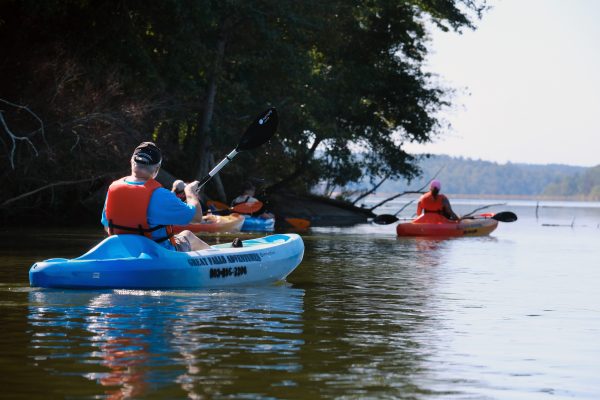
Where the hard rock of the Piedmont gives way to the sandy Coastal Plain, two company towns that lost their companies are looking for economic revival to the rivers that put them on the map.
Great Falls in South Carolina and Badin in North Carolina grew up along the geologic fall line beside wild, majestic stretches of whitewater that entrepreneurs harnessed for electricity and for industry — James B. Duke in Great Falls and Andrew Mellon in Badin — a quintessential American story retold up and down the East Coast in the early 1900s.
Now, years after the textile mills in Great Falls quit spinning on the Catawba River and the aluminum smelter in Badin shut its furnaces on the Yadkin, both towns hope to reinvent themselves with a new kind of industry: ecotourism.
“Just look at it!” Mike Vaughn said as he steered his jon boat along the towering rock cliffs of Dearborn Island a quarter mile from Great Falls. A great blue heron rose gracefully from the shallows as Vaughn motored on, aiming for two stretches of riverbed known as reaches. The rocky alleyways are remnants of the once mighty “Great Falls” that gave the town its name. They have been mostly dry since dams diverted the Catawba River for electricity.
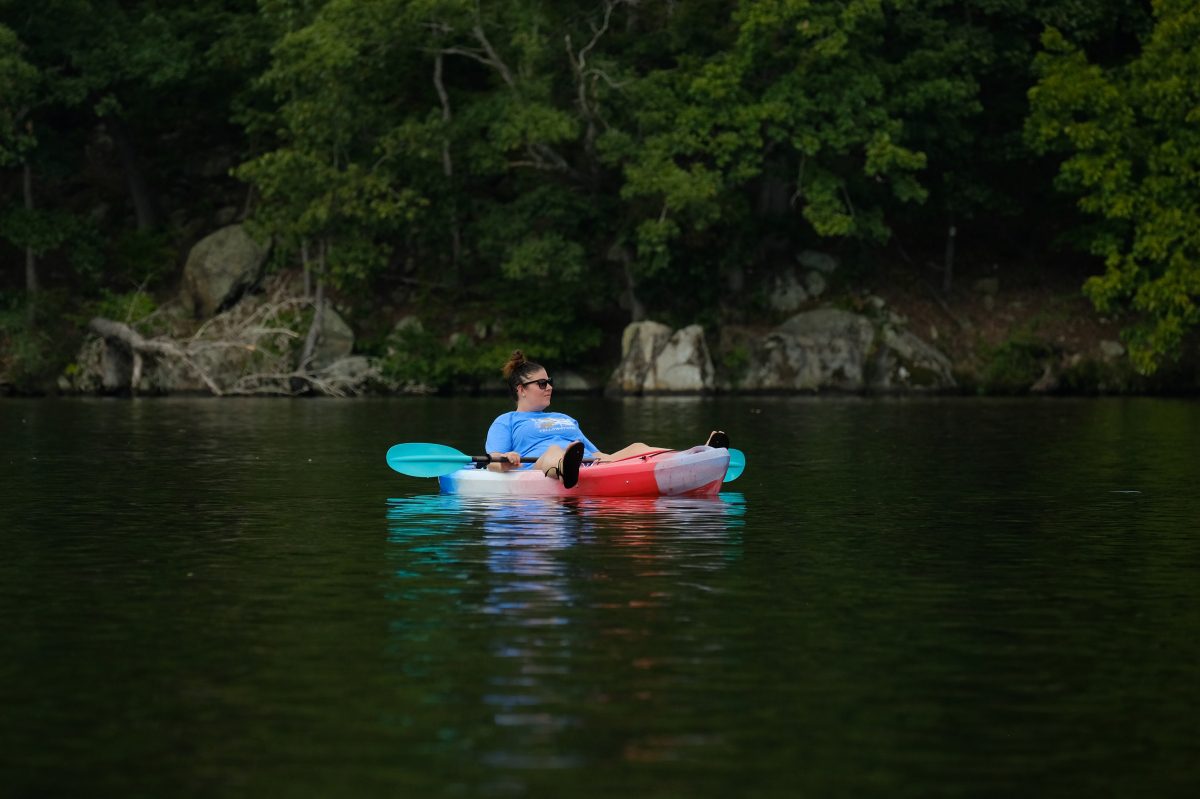 Photo Gallery: Badin, Great Falls seek to embrace their rivers for a rebirth.
Photo Gallery: Badin, Great Falls seek to embrace their rivers for a rebirth.
Vaughn stared up at the riverbeds and envisioned his hometown’s revival, pinning his hopes on Duke Energy’s planned rediversion of whitewater back into the two reaches.
“This is going to be an economic engine for the entire county,” said Vaughn, a Chester County council member and avid kayaker. “There will be nothing like this between Columbia and Charlotte. People will come here for the whitewater. It’s going to be a wilderness experience.”
A similar scene played out 80 miles away near Badin. Vanessa Mullinix, a local businesswoman, looked out over the scenic Falls Reservoir where the Narrows — or “The Great Falls of the Yadkin” — once plunged with a violent froth through a long, narrow gorge. These days fishing boats hug the quiet shoreline and eagles soar overhead.
“We’re a hidden little gem in the middle of the state,” Mullinix said. “This river is what brought the Native Americans here. It’s what brought the French in who built the aluminum smelter. And it’s what will bring people in from Charlotte and Greensboro and Fayetteville.”
The Carolinas Urban-Rural ConnectionA special project from the UNC Charlotte Urban Institute |
|---|
Sheer rock cliffs, like those near the town of Great Falls, rise up from deep within the water. On one side of Falls Reservoir stretches Morrow Mountain State Park, with more than 15 miles of hiking trails, 16 miles of horse trails and half a million visitors each year; on the other, a stone’s throw across the water, lies the sprawling Uwharrie National Forest, with some of the oldest mountains in the nation and 1.2 million visitors each year.
At the center of this remarkable green space in the middle of North Carolina, halfway between the Blue Ridge Mountains and the Outer Banks, sits historic Badin.
“We are the gateway,” Mayor Anne Harwood said.
Harwood and town manager Jay Almond are counting on the lure of natural beauty to help replace revenue lost in 2002 when the aluminum plant shuttered.
“People can drive 45 minutes to an hour and a half and have the kind of experience they might otherwise have had to drive all the way to the Blue Ridge Parkway to get,” Almond said. “We just need a little connectivity between the town, the lake, the mountain, the reservoir, the national forest and the state forest.”

Badin manager Jay Almond. Photo: Nancy Pierce
Badin and Great Falls, like other small manufacturing towns across the Carolinas, helped fuel the growth of the region and Charlotte’s rise as a prosperous urban center in the early 20th century . That interdependence faded after the smelter shut down and the mills closed. In addition to local revitalization efforts, both towns are looking to restore the urban-rural connection. Their future depends on it.
“We see a regional benefit,” Almond said of Badin’s plans. “There are some really rich opportunities for us to be the kind of place people can be enriched by. We need to get the message out there and they need to give it a shot.”
‘We had it all’
The original plans for Badin came from a French industrialist named Adrien Badin. He began building a dam at the Narrows to power an aluminum plant and a town nearby for employees. The community was laid out in the European garden city-style, with streets following the lay of the land and a mix of cottages and apartment-style homes, many of which retain their old-world charm.
On the town’s website, Badin’s mission statement is still written in both English and French. But in 1915, the French left to fight in World War I and Andrew Mellon’s Aluminum Company of America (Alcoa) took over the project.
David Summerlin, 82, directs the Badin Museum. He worked for Alcoa and remembers the town in its heyday. “We had plenty of businesses — drug stores, grocery stores, dime stores, hospitals,” he said. “We had a theater. We had schools and ball fields and an opera house. We had it all.”

View of the Badin Dam from Falls Reservoir (which is below this dam) near Badin. Photo: Nancy Pierce
For nearly 100 years, Alcoa was the major employer — and the major benefactor. After the company closed, Badin lost nearly half of its tax base and most of its businesses. Its main shopping district now has two shops, both selling antiques.
The aluminum factory’s hulking metal skeleton still stands at the center of town. There are now about 1,800 residents, including 850 inmates in a nearby prison that the town annexed for revenue, down from a high of 5,000 residents.
“For so long, we had such a reliable manufacturer that there wasn’t a Plan B developed,” Almond said. He now has a Plan A, B and C (5-year plan, 10-year and 15-year) all displayed on the walls of the Town Hall, formerly B.T. Garrison’s grocery store.
A protracted legal battle between Alcoa and North Carolina over control of the Yadkin River and its dams held up all but Plan A, which included new streetscapes and trees in Badin’s business districts. In April, the state agreed not to appeal a ruling in Alcoa’s favor. Alcoa is moving forward with a federal relicensing settlement agreement, which required the company to transfer some of its land to the public (although another company now owns the dams).
Badin can finally move forward, too.
Alcoa will donate 14-acres to the town for a waterfront park. Almond said Badin will rely on grants to pay for an amphitheater, picnic tables and trails (that’s Plan B, the 10-year-plan).
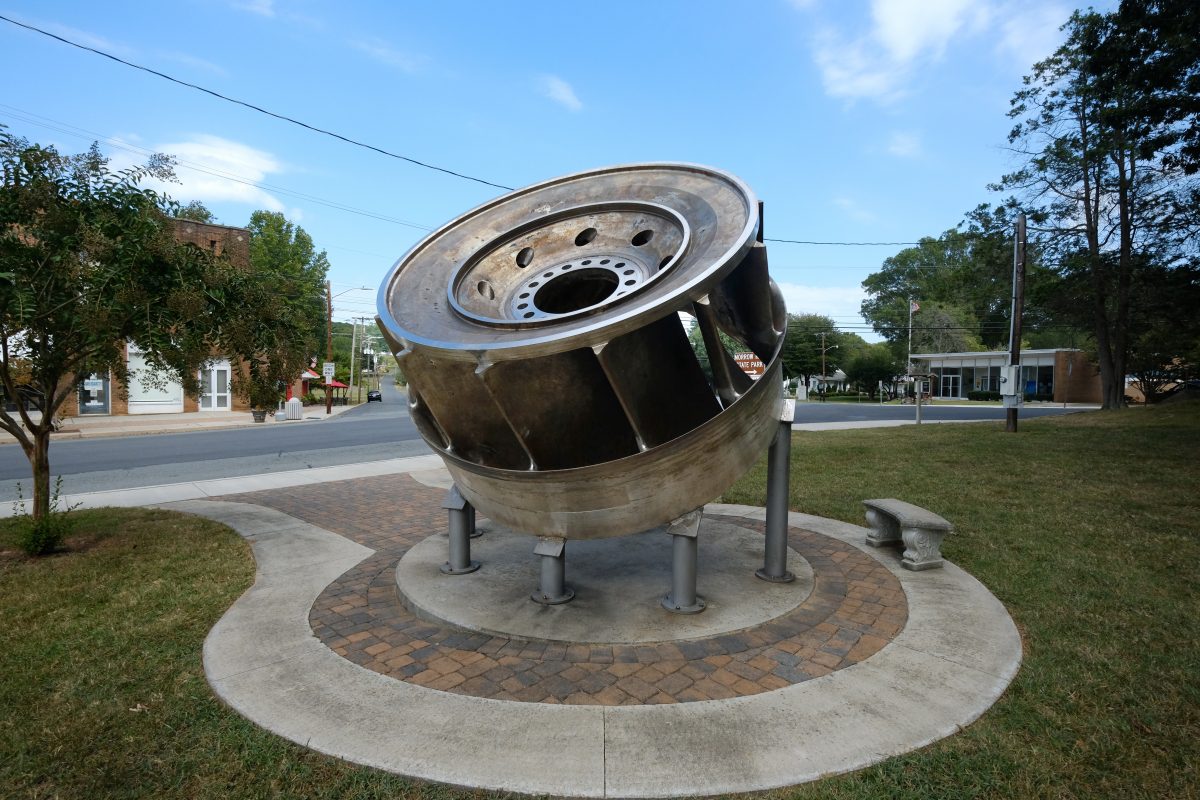
On display in downtown Badin, this 28,400 pound, 10-foot diameter stainless steel water wheel powered the 36,000-horse power generator for Narrows Dam from 1988 to 2009. The power plant is on the National Register of Historic Places.
Alcoa also is donating 1,180 acres to Morrow Mountain State Park, including one of the nation’s most significant Native American archeological discoveries, the Hardaway Site, where settlers 12,000 years ago excavated rhyolite stone for arrowheads and tools. Once the transfer of the land is complete, the state park will abut town limits. (Plan C)
“It’ll kind of wrap around half of Badin, so Badin will definitely be receiving a lot more traffic through their town because of the state park,” said Jeff Davidson, park superintendent.
In anticipation of those visitors, Mullinix reopened the Badin Inn, which was built in 1913 and stood vacant for nearly two years. She said she wouldn’t have gambled and bought the inn if she didn’t think the town’s ecotourism plans would pan out.
“Badin is on the verge of exploding,” predicted Chris Lambert, executive director of the Stanly County Convention and Visitors Bureau. “Once they get a few more unique stores and some restaurants, I think it could really blow up — in a good way. It’s a quaint little French village.”
‘Like paddling in the mountains’
By contrast, many former mill homes in Great Falls fell into disrepair after the town’s three Republic Cotton Mills, built between 1910 and 1923 by James B. Duke, closed one after the other.
Former Mayor Don Camp was the last employee to leave Republic Mill # 3 in 1985. He remembers the day: Nov. 15. He was working as a supervisor, having picked up additional responsibilities as closure drew near.
“It was devastating,” he said. “Suddenly, everything was silent. I shut out the lights and left. Everything went dark.”
People abandoned the town and stores closed. Those who stayed (around 1,900 residents now, down from nearly 5,000) were forced to commute dozens of miles for jobs to Rock Hill, Lancaster, Columbia, Charlotte — and still do.
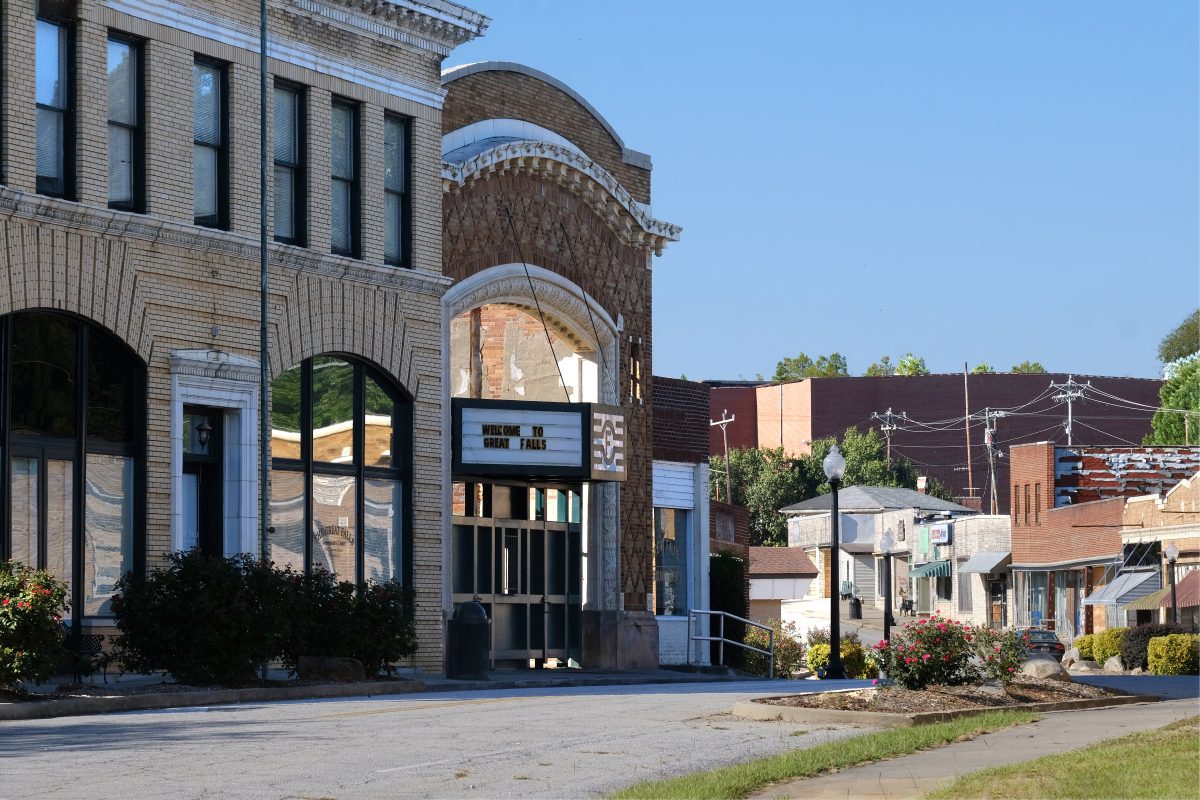
Downtown Great Falls. In the middle is the Republic Theatre. The roof caved in, so all that’s left is the front facade. Photo: Nancy Pierce.
The business district is a ghost of its former self. The roof collapsed on the once-elegant Republic Theater, where opening night featured “The Kid” starring Charlie Chaplin. Other buildings remain boarded up or roofless. Buzzards nest in the chimney top of the abandoned company store-turned Belk Department Store.
“You couldn’t make a business survive because our population was dwindling,” Vaughn said. “It took a toll on the morale of the people who were still here.”
Despite its challenges, Great Falls has one thing going for it that Badin lacks: Funding for the centerpiece of its ecotourism plans. As part of Duke Energy’s relicensing agreement with the Federal Energy Regulatory Commission (FERC), giving it authority to manage the Catawba River, the company must pay for recreational improvements near Great Falls.
Duke agreed to periodically release water into the two former whitewater channels. The longer reach, about 1.5 miles, will feature a gentler paddle with Class 1 to 3 rapids. The shorter, one-half mile reach will be faster and more challenging with Class 3 to 5 rapids.
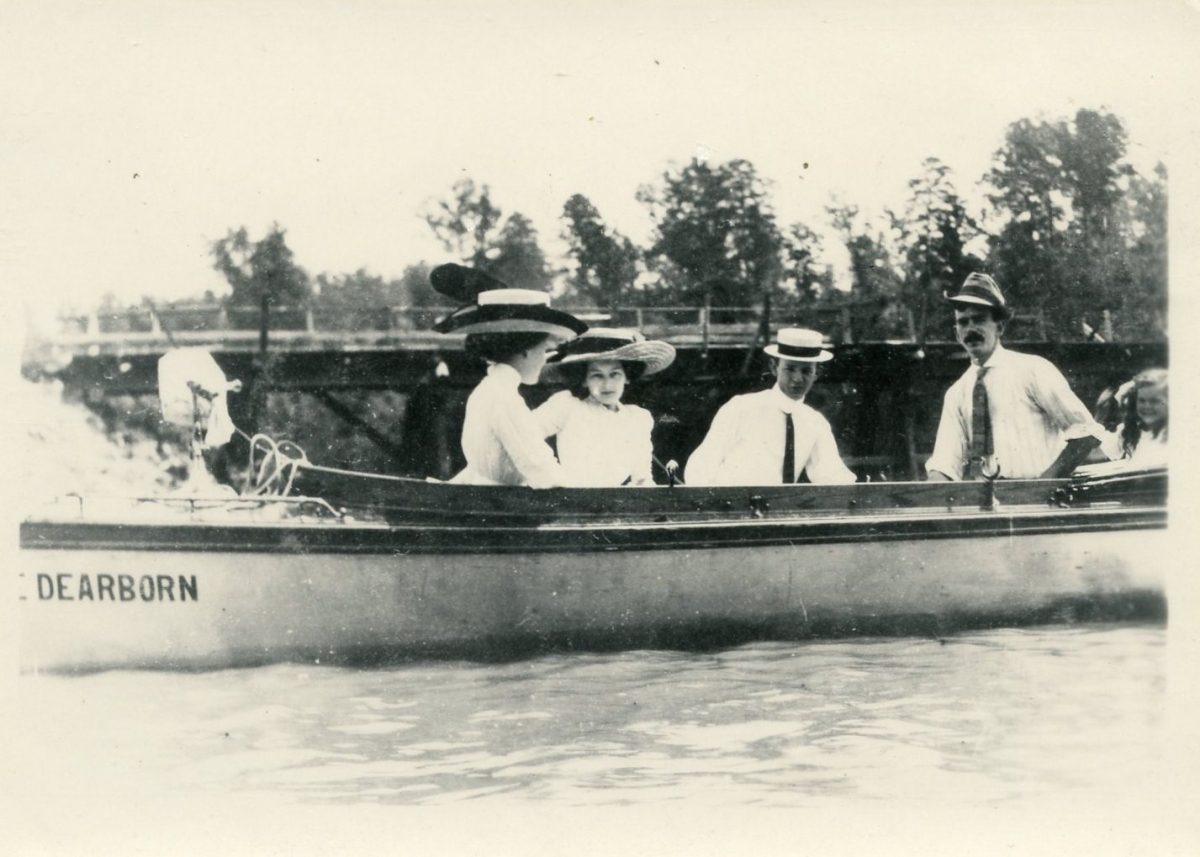
Boaters on the river near Great Falls at around the turn of the century. Photo courtesy Duke Energy.
“Once you enter those old riverbeds, you’ll see nothing but rock cliffs on the side of the islands and animals and birds,” Vaughn said. “It will be like paddling in the mountains.”
Duke has consulted with a number of companies to make the channels navigable and safe, including S20 Design, which designed the U.S. National Whitewater Center in Charlotte. Construction is expected to begin by late 2020 or early 2021 and take two years.
“We think it will be a game-changer,” said Karlisa Parker Dean, director of Chester County Economic Development. “It will help jump-start other things.”
The ties between the urban energy giant and small town Great Falls have strengthened during the planning process. If all goes as planned, Duke will invest an additional $1.2 million for a pedestrian bridge connecting the town to Dearborn Island, which was created when the river was dammed. That financial commitment is contingent upon the South Carolina Department of Parks, Recreation & Tourism developing the island into a park, which has yet to be approved by the state.
Vaughn and Glinda Coleman, executive director of the Great Falls Hometown Association, hiked along the ridge of the island, taking in the sweeping views of the water on the far side and the granite ruins of a 19th-century federal armory.
“People who have lived here all their lives have no idea the water is so close,” Coleman said. “When we get the bridge” — and she’s confident they will — “people will be able to walk to the water from town.”
In years past, success in Great Falls was measured by tiny improvements — adding a fresh coat of paint to the former Winn Dixie, picking up trash from the river. On the town’s website, under “economic development,” it says “coming soon.”
“We set goals some time ago, in 2000 or 2001, and we really didn’t have the means to pay for them,” Coleman explained. “But when Duke was doing this relicensing and we were identified as stakeholders, we were able to work with them to get a lot of things done.”
Community leaders visited two former North Carolina mill towns to learn how those communities reinvented themselves — Cramerton on the South Fork River, with a new riverside park and greenway, and Saxapahaw on the Haw River, where a former mill was renovated into high-end apartments and businesses.
“My observation from the little towns we’ve looked at is it’s not a huge thing that occurs,” said Great Falls town councilman Glenn Smith. “It’s a little thing that starts and gets built on. Kayakers have told us there will be businesses wanting to locate here that we haven’t even thought of. They will follow the kayakers.”
Vaughn isn’t waiting. He bought eight kayaks and launched Great Falls Adventures offering rentals and guided tours.
“We’re expecting a huge influx of people,” Vaughn said.
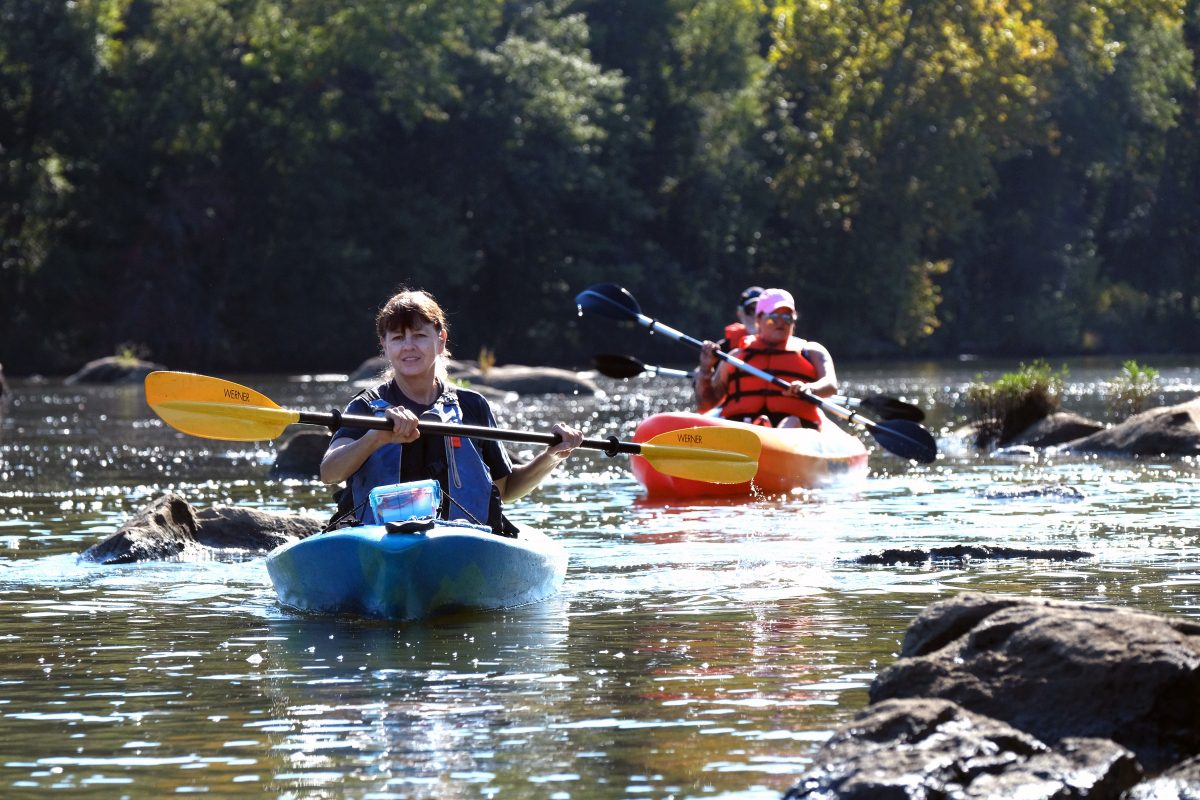
Paddlers on Stumpy Pond near Great Falls. Photo: Nancy Pierce.
In 1809, historian David Ramsay wrote that the scenery around the Great Falls of the Catawba “is sufficiently grand and curious to attract the visits of the most distant inhabitants of Carolina.”
With similar exuberance in North Carolina, newspaper articles from the early 1900s described the Great Falls of the Yadkin as “the Niagara of the South,” “picturesque and beautiful” with “a surging, rolling, foaming, angry current.”
More than one hundred years later, both towns are counting on that natural beauty to give them a second chance.
Elizabeth Leland